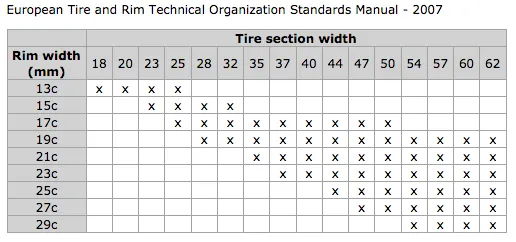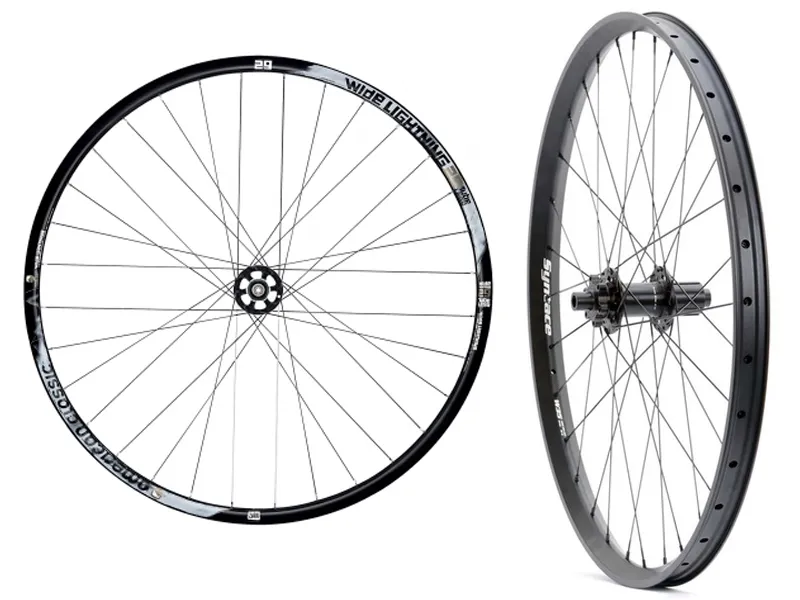From handlebars to bottom brackets to wheels, almost all the components that make up modern mountain bike are increasing in diameter, length or both. But there’s one component that has been notably resistant to change: the bicycle rim.
Despite changes almost every other part of the mountain bike, most mountain bike rims remain just a few millimeters wider than rims supporting 23mm and 25mm-wide road tires. What gives?
Part of this width discrepancy is a vestige of our mountain biking heritage. The pioneers of the sport cobbled together their machines with hand-me-downs from other genres of cycling. Keith Bontrager, for example, went dumpster diving for discarded 700c Mavic MA-2 tandem rims to cut down into the first lightweight aluminum 26in mountain bike rims. Many of the rims we ride today are not much wider than his creations, despite the fact that most of us run significantly wider tires.
“We see people going wider even for cross-country, but especially for trail and DH riding,” said Aaron Chamberlain, marketing specialist with Maxxis tires.
“You won’t see many 1.9in or 2.0in projects coming out these days; most of our projects are in the 2.2in and 2.35in range, even for general trail use,” he added.
Mike Bush, an engineer with Stan’s NoTubes, notes a similar trend: “When [Stan’s Notubes] started, 1.9-2.1in XC/trail tires were the norm. Now the 2.3-2.4in seems to be the sweet spot for general trail riding for the majority of our customers right now.”
The other reason for the slow movement towards wider rims has to do with adherence to standards set forth by the European Tire and Rim Technical Organization (ETRTO) in conjunction with the International Organization for Standardization (ISO), which layout a framework for rim and tire compatibility.

This table shows possible combinations of tire and rim widths according to ETRTO
These standards aim to reduce compatibility issues across manufactures and ensure safety for riders—both admirable goals. Unfortunately, these standards have failed to keep pace with changing technology within our sport.
As a result, an increasing number of companies no longer stick to ETRTO guidelines for rim width as it relates to tire width. Even companies such as Mavic, who are firm proponents of ETRTO guidelines, recognize that it may be time to re-evaluate rim ideal rim widths.
“It’s probably time to revisit ETRTO. Mostly related to mountain bike standards,” said Mavic communications manager Zack Vestal.
The case for going wider
“Lighter and stiffer” are the pair of adjectives most frequently bandied about as reasons to upgrade to larger diameter components—be it a steerer tube, bottom bracket spindle or handlebar clamp. But when it comes to rims, it is not so much about shaving grams as it is about increasing tire volume and improving stability.
Switching to wider rims can dramatically increase the volume of a given tire. Increasing the distance between the bead seats and has the additional benefit of flattening out the tire’s sidewalls, giving the tire more support and helping it to resist rolling or squirming at low pressures. Think of this in terms resisting someone attempting to push you over with your feet close together versus spread apart in an athletic stance. The later position will allow you to resist more force.
“A wider rim allows the tire beads to be moved further apart and therefore creates a more stable tire. With what is essentially a wider foundation under the tire (beads spaced further apart), lower pressures can often be used which leads to better traction, control and comfort,” said Bush.
Leading the way
A handful of companies, including Syntace and American Classic, have introduced wheelsets built around rims that are up to a centimeter wider than many other mountain bike wheelsets on the market (and well outside of ETRTO guidelines).

The Syntace W40 wheelset (right) has an internal width of 33.5mm, while American Classic’s new Wide Lightening series (left) has an internal width of 29.3mm
The increasing use of carbon fiber in rim construction can take some of the weight penalty associated with wider rims out of the equation. Expect to see a number of wide (25-30mm) carbon fiber wheelsets in the coming years.
How wide is too wide?
That’s a question that’s yet to be determined, as rim design and tire design need happen in concert with one another.
“There are limits to what will work effectively with the tires currently available. Two-wheeled vehicles need the tire to have a bit of a crown to corner properly and engage the side knobs in a predictable and controllable manner. If one pushes the tire-to-rim width ratio too far then cornering will become an issue. For a 2.3in tire we would consider 20mm internal rim width to be the minimum and 30mm a good maximum for the tires currently available,” said Bush.
What do you think? Have you experimented with wider rims?
